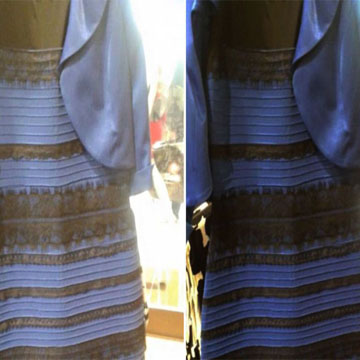
This dress created a great debate of what color it actually was. Now, a U.S. researcher has dug deeper into the why and what of color perception in regards to this infamous dress. [Image: Tumblr]
Just over two years ago, the world witnessed the internet phenomenon of “The Dress”: A photo of an unusual wedding dress went viral, as online arguments erupted over what color the dress actually was. Some viewers swore that it was white and gold; others claimed it was blue and black. Now, a researcher New York University (NYU), USA, who has spent part the past two years writing think pieces on the vision science underlying the phenomenon of The Dress, has proposed an answer to the quandary—the photographed dress’ color depends on the assumptions we bring to the table.
In a study published this week in the Journal of Vision, (doi: 10.1167/17.4.5) NYU clinical psychologist Pascal Wallisch argues that differences in subjective perception of the dress’ color were influenced by how viewers thought the dress was illuminated—that is, whether they thought the dress was under natural light, artificial light, or in shadow (J. Vision, doi: tk). And, he suggests, those assumptions about illumination could partly hinge on our individual lifestyle choices, such as whether we tend to get up early or sleep late.
One size doesn't fit all
To get at the question of“whether the subjective interpretation of the dress stimulus can be accounted for individual assumptions about illumination,” Wallisch conducted two online surveys. One survey, involving some 8,000 respondents, took place in March 2015, shortly after The Dress first caused an internet sensation; the other, involving more than 5,300 respondents, was conducted a year later, in March 2016.
Both surveys posed baseline questions such as what color respondents perceived the dress to be the first time they saw it and whether their perception of the color had since changed. In the first data run, the survey also asked participants whether they thought the dress was presented in a shadow, whether they themselves spent more time inside and outside, and other self-identification questions. In the second run, the survey asked these same questions, but added another—whether a participant thought that the dress was illuminated by artificial or natural lighting.
Idiosyncratic perception
In the first data run, 59 percent of participants reported seeing the dress as white with gold lace trimmings, as opposed to the 27 percent who saw it as blue and black. Additionally, nearly 9 percent of respondents saw the dress as a combination of blue and gold, and less than 1 percent saw it as white and black. Just over 1 percent saw it as “switching” or ambiguous in color, and nearly 3 percent reported seeing unspecified other colors. The results from second run were similar.
Further, Wallisch notes that—“reassuringly”—his survey results align with reports from other large-scale, online efforts that assessed the issue of color perception. In the other online studies, as well as Wallisch’s present one, the majority of participants reported seeing the dress as white and gold. Given this, Wallisch considers white and gold to be the “canonical percept” versus all other possibilities.
Shadow of a doubt
More intriguing, however, were the surveys’ findings on how participants’ assumptions and individual backgrounds affected their perception of the dress.
Among who believed that the photo showed a dress in the shadows, for example, some 75 percent thought it was white and gold, versus fewer than 50 percent of those who though the dress was not photographed in the shadows. And assumptions about the light source also played a role, according to Wallisch’s results. Those who thought the dress was photographed under natural light were nearly one and one-half times more likely to report a white-gold color combination than those who thought it was photographed under longer-wavelength, artificial light.
Wallisch then tied these results to other survey responses regarding personal habits and “circadian type.” Those who tend to go to bed early and are active in the morning (whom he dubbed “larks”), he found, were considerably less likely to assume that the dress was illuminated by artificial light than were late sleepers active at night (“owls”).
These patterns, Wallisch suggests, may have played a role in individual responses to the phenomenon of The Dress. Bottom line: “Your assumptions about the illumination source will matter,” Wallisch says, “and those might depend on lifestyle choices, such as when you go to sleep.”
